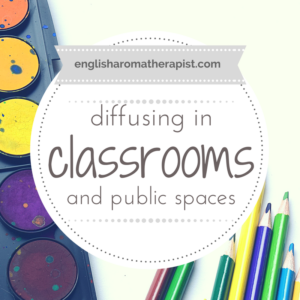Diffusing in the Classroom

Diffusing essential oils in the classroom – what are your first thoughts?
As you know, I do love a juicy topic to get my teeth into – and this is a subject I’m increasingly reading about online.
Diffusing in classrooms, waiting rooms and other public places is rapidly on the rise – particularly in the US, although I’m starting to see evidence of this in the UK now too.
I’m aware this subject has been written about before, so I thought it would be useful to create a collection of information and links for your reference. I often see questions about this on Facebook, and sometimes it’s useful to have all the relevant evidence in one place.
What’s going on?
It appears to be increasingly common for essential oils to be regularly diffused in schools, nurseries, shops, medical waiting rooms and other public places. The practice is promoted as a way to purify the air, improve wellness and create a generally pleasant atmosphere.
Unsurprisingly, the majority of these initiatives are derived from doTerra and Young Living. Seemingly on a mission to take over the world with essential oils, doTerra now wants to infiltrate your child’s classroom (with brochures like this).
“Wellness advocates” are encouraged to introduce essential oils into schools through fundraising events. Teachers are persuaded to diffuse in the classroom and use cleaning products from the OnGuard range. Much of the persuasive material centres around the claim that these oils are “certified pure therapeutic grade” and therefore 100% safe.
The concept is sold on the basis that essential oils are pure, natural and universally safe for everyone. This usually comes with a side-order of guilt about the synthetic chemicals our children are normally exposed to on a daily basis.
Aside from schools, diffusion is becoming increasingly commonplace in public areas. Even some hospitals are diffusing oils to create a more relaxing and pleasantly-fragranced atmosphere – spot the doTerra bottles in this video.
Recently, I spotted a tweet from a dentist, proudly stating they diffuse doTerra’s ‘Breathe’ blend every Monday. This is just one of many examples I see online every day – the majority of which recommend daily diffusion of OnGuard (which is doTerra’s equivalent to Thieves blend – find out more about this here).
In a quest to find out more, I recently joined a Facebook group set up to promote the use of doTerra in schools. Scrolling through the posts, I was horrified at some of the suggestions. One teacher asked how to protect children from the flu and was told to diffuse OnGuard all day, clean their hands with OnGuard handwash and sanitise all surfaces with OnGuard spray. In addition, it was suggested that parents could be persuaded to get on board with the practice of daily diffusion by explaining that the oils have GRAS status (read more about what GRAS actually means here).

So what?
What’s the problem with diffusing essential oils in classrooms and public areas? Sounds lovely, right? After all, it’s proven that people respond better to a pleasant fragrance (read more about scent marketing here).
Well, there are several reasons why this is NOT a good idea.
1. Constant diffusion is not a good thing
Diffusion should always be done with care – even in your own home. I’ve talked before about why diffusing continuously over long periods of time is not recommended. Blends like OnGuard contain known irritants, such as Clove and Cinnamon Bark – do you really want to be breathing them in all day, every day?
I’m not seeing any cautions about taking breaks or ensuring there is an adequate supply of fresh air. Do you actually need to diffuse ANY essential oil continuously? About half an hour is usually sufficient. Over-exposure can cause headaches or nausea. Unfortunately, not everyone realises this – particularly if they have been sold the idea of immunity support and wellness. I’m sure this daycare centre in Idaho, USA had the best of intentions when diffusing a cinnamon blend around toddlers, and didn’t anticipate it would result in an emergency call.
Parents are being encouraged to diffuse all day (and all night!) to protect their family from germs. Personally, I don’t diffuse on a daily basis at home. I certainly wouldn’t want my children to be inhaling oils continuously. You have to question the motive for 24/7 diffusion – call me cynical, but I just see this as a way of using up those bottles faster. The more you use, the more you need to buy!
2. Unpredictable reactions
Amongst all this propaganda, no mention is made of checking individual health concerns. In a classroom of 30 children, several could have allergies or medical conditions that might contra-indicate the use of certain (or any) essential oils.
Remember, these are children – with systems that cannot metabolize essential oils the same way as adults.
Even outside the classroom – why diffuse essential oils in confined waiting areas? Some of your clients may be pregnant, some may have specific allergies or aversions to particular oils. Breathing is not optional – so if you’re in the room, you’re breathing it in.
It is misleading to suggest that essential oils are so pure they’re free of any potential side-effects. A teacher is not trained in aromatic medicine, and cannot possibly know how individual children will react to oils. Anyone can experience a reaction to an essential oil – no matter which brand!
Some people are more sensitive than others. No essential oil is universally safe for everyone – even Lavender can cause headaches or hyperactivity for some people (read more: Why Lavender is Not Always Relaxing). Some oils can cause seizures or other adverse reactions. And even if no initial reaction is apparent, regular exposure can cause sensitization issues over time.
We are all unique individuals. Professional aromatherapy is about using essential oils in a carefully tailored and considered way. It has never been about incorporating oils into every aspect of your life, constantly inhaling and ingesting them on a daily basis.
3. A Germ Free Zone?
Everyone knows classrooms and play areas are germ factories. Obviously, we want to try and create a clean, healthy environment for our children. But “clean” is one thing – “sterile” is another. Despite online claims, you cannot create a “Germ Free Zone” by diffusing essential oils. It’s impossible to eliminate all bugs and germs – and nor should we want to! After all, we need exposure to a certain amount in order to build an immunity system.
4. Profit-driven?
These initiatives are usually well-intentioned, and I understand why parents are led to believe this is a positive step forward. But should we be encouraging cash-strapped schools to spend over the odds to use doTerra products every day? The often-recommended OnGuard handwash costs over £20 for a 473ml (16 fl.oz) bottle. How long would this last in a busy classroom?
5. Consent
It’s not acceptable to diffuse essential oils around children without parental consent. Even if permission is obtained, do parents truly understand the implications of what they are consenting to? Are they being presented with biased marketing material, or balanced facts? And if 90% agree, do the opposing 10% just have to put up with it?
6. Scent preference
So, what’s wrong with just diffusing essential oils to create a pleasantly-scented waiting room or public space? Well, scent perception is extremely subjective. A fragrance you love can be repulsive to someone else. Strong oils like Patchouli and Geranium can be incredibly divisive. Some people are sensitive to ALL fragrances. Do you want to risk turning customers away, or making them feel uncomfortable?
But what about…?
Inevitably, advocates of classroom diffusion will argue that it’s safer and preferable to chemical cleaning products. This is really a separate issue (see Red Herring fallacy). Of course we don’t want our children breathing in synthetic plug-in air fresheners, aerosols or toxic chemicals. But nor do we necessarily want them to be breathing in essential oils all day long either!
Just because essential oils are natural it doesn’t mean that:
a) they are universally safe
b) they can be used without caution

What should you do?
If you find out that essential oils are being diffused in the classroom, don’t hesitate to speak to the head teacher. You have a right to voice any concerns that relate to your child.
Usually, these initiatives are well-intentioned and the decision-makers aren’t always aware of the potential risks. My advice would be:
- Remain calm
- Be polite
- Stick to the facts
It’s helpful to present evidence to support your case. Print off this article – plus the ones listed in the ‘Further Reading’ section, if necessary.
Try to keep it positive – we don’t need to be the anti-aromatherapy brigade. I’m obviously not against essential oils – but I am pro-safety. Let’s spread awareness of how essential oils can be used in safe, healthy and positive ways.
As a compromise, you could suggest that the diffuser is only run for 30 minutes after school is over. At least this would minimize direct exposure for the children.
When researching this topic, I’ve come across requests for advice regarding how to approach a school to raise concern about classroom diffusion. Sometimes it’s difficult to know where to begin. So, I’ve created a letter document you can use as a template – feel free to download it and amend as required:
Click here to download Letter Template to Education Providers
The future?
I’ve recently written about my concerns regarding the aromatherapy industry. The growing amount of misleading and dangerous “advice” spread by unqualified reps threatens to damage its integrity.
People are being encouraged to use essential oils inappropriately and, ultimately, people are experiencing negative consequences. We don’t want essential oils to become too tightly regulated – or even banned – as a result.
I’d love to hear your thoughts about diffusing essential oils in the classroom and other public spaces. Is this the future of wellness, or have we opened a can of worms? Let me know in the comments below!
Further Reading:
- https://lifeholistically.com/essential-oils-classroom/
- https://www.planttherapy.com/blog/2016/01/07/classroom-diffusing/
- http://essentialaromatherapy.org/doterra-is-drugging-your-children/
- https://www.diffuseressentials.com/diffusing-essential-oils-classroom/
- https://www.facebook.com/RobertTisserandEssentialTraining/posts/1081720331859167
What to read next: Why you don’t need to diffuse all day
Follow me on...
Share this on...
